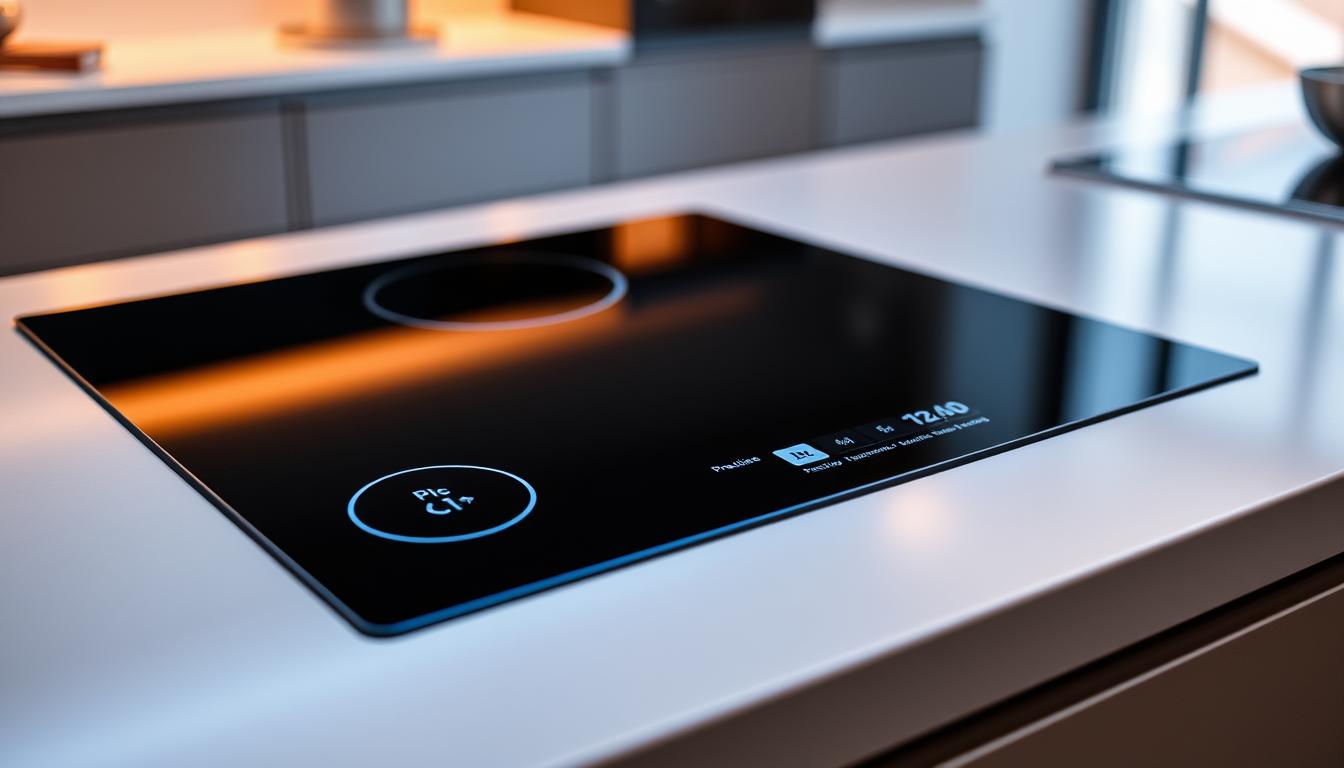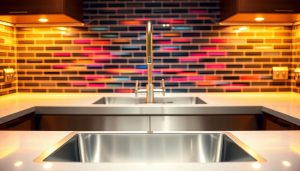Modern kitchens are undergoing a silent revolution, with induction-based systems leading the charge. These devices do more than heat pans – they learn your habits, adjust to your recipes, and even communicate with other appliances. Samsung and LG now offer models that sync with Wi-Fi-enabled hoods and microwaves, creating a unified cooking ecosystem.
Imagine adjusting burner temperatures from your couch or receiving alerts when water reaches a boil. Today’s technology goes beyond basic touch controls, using sensors to prevent overcooking and algorithms to optimize energy use. Brands integrate voice commands and app-guided recipes, turning complex dishes into simple step-by-step processes.
The real magic lies in how these features work together. Your cooktop can automatically activate ventilation when smoke appears or lower temperatures if it detects unattended cookware. This isn’t just convenience – it’s a new standard for kitchen safety and efficiency.
Key Takeaways
- Sync with smartphones and home systems for remote monitoring
- Precision temperature controls eliminate cooking guesswork
- Voice commands and touch interfaces simplify operation
- Built-in sensors prevent accidents and energy waste
- Compatible with other smart kitchen appliances
- Guided cooking modes enhance culinary results
Introduction to Smart Cooktops
Kitchens now serve as interconnected hubs where culinary tools evolve beyond basic functionality. Cutting-edge systems combine electromagnetic heating with digital intelligence, redefining how you interact with cooking surfaces.
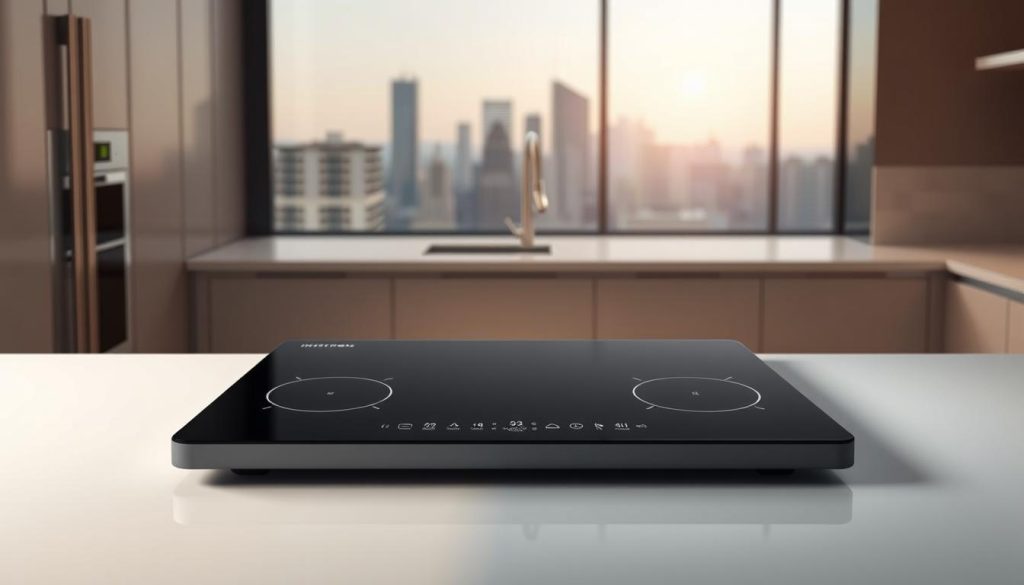
Understanding the Shift in Kitchen Technology
Traditional burners are giving way to appliances that think. LG’s latest models demonstrate this leap – their induction systems target pans directly, leaving surrounding surfaces cool. This precision pairs with wireless connectivity through the ThinQ app, letting you orchestrate multiple devices simultaneously.
Your kitchen ecosystem now learns from patterns. Morning coffee rituals trigger synchronized appliance prep, while evening meals activate ventilation before smoke forms. These interactions create seamless workflows that adapt to your lifestyle.
Why Upgrade to a Smart Cooktop?
Immediate benefits include 40% faster boiling times and exact temperature adjustments down to single-degree increments. Safety enhancements like automatic pan detection prevent accidental burns – a game-changer for families.
Energy savings become tangible through responsive heat management. One study showed induction cooktops use 20% less power than conventional models while delivering superior performance. Integration with voice assistants and recipe apps turns complex dishes into guided experiences.
“Smart cooking surfaces aren’t luxuries – they’re the new baseline for efficient, safe meal preparation.”
Future-ready designs ensure compatibility with emerging smart-home standards. Your investment today positions your kitchen for tomorrow’s innovations without requiring costly upgrades.
Smart vs. Traditional Cooktops
Kitchen upgrades now hinge on performance and adaptability. While conventional options dominated for decades, modern systems redefine expectations through precision and connectivity. Electromagnetic technology and intelligent interfaces create distinct advantages over older methods.
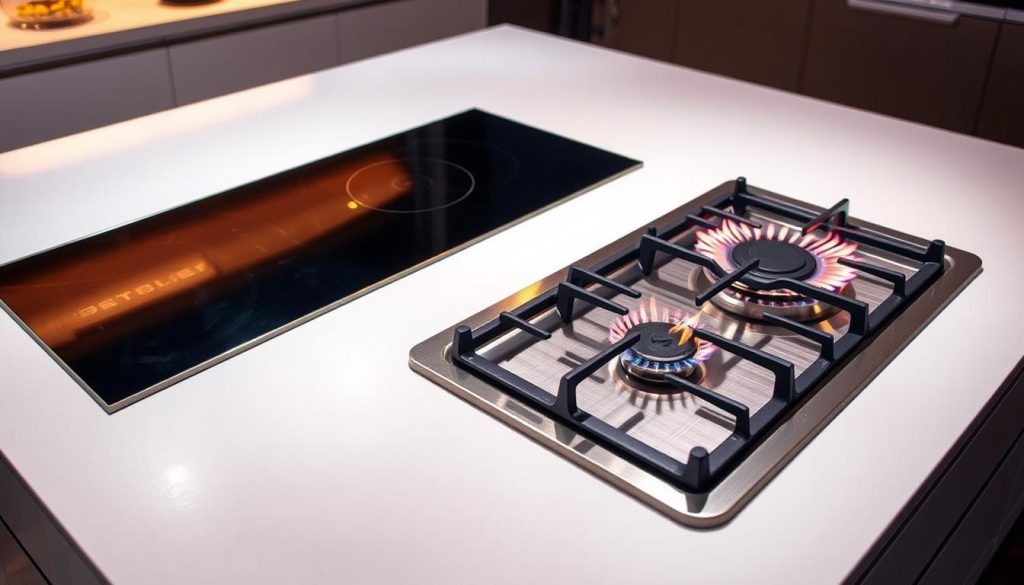
Comparing Features and Benefits
Induction cooktops outperform gas and electric models in speed and control. Tests show water boils 30% faster than radiant-electric versions, matching or exceeding gas burner speeds. Direct heat transfer eliminates wasted energy, keeping kitchens cooler during summer months.
Digital interfaces replace clunky knobs with touch-sensitive controls. Adjust temperatures to the exact degree or select preset modes for frying, simmering, or melting chocolate. Traditional models lack this granularity, forcing guesswork with inconsistent results.
Cleaning becomes effortless since spills don’t bake onto smooth surfaces. Unlike gas burners with removable grates or coiled electric elements, induction models wipe clean in seconds. Safety enhancements like automatic shutoffs and pan detection add layers of protection absent in older designs.
Energy savings compound over time. Smart cooktops redirect power only when compatible cookware is present, unlike gas models heating air or electric coils warming empty spaces. This efficiency reduces utility bills while minimizing environmental impact.
Core Features of a Smart Cooktop
Contemporary cooking surfaces transform meal preparation through cutting-edge interfaces and precision engineering. These systems combine responsive design with adaptive technology to elevate every culinary task.
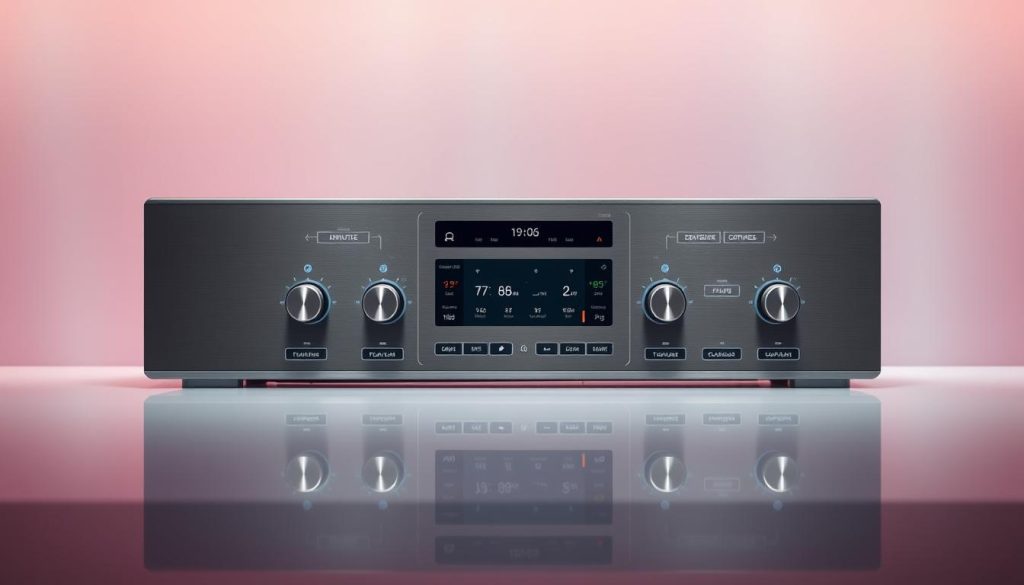
Innovative Control Panels and Interfaces
Your interaction begins with intuitive layouts. Horizontal slider bars dominate modern models, letting you swipe through power levels like adjusting smartphone brightness. High-end versions feature LCD touchscreens that display real-time temperature graphs and recipe timers.
Fridgidaire Professional models demonstrate versatility with physical knobs for tactile feedback. Wheels and touch-sensitive zones offer alternative navigation styles. These features ensure seamless operation whether you’re sautéing vegetables or melting delicate sauces.
Advanced Temperature Management
Precision defines modern heat regulation. Standard models provide 10 preset levels, while premium cooktops deliver 15+ micro-adjustments. This granularity prevents scorching and maintains perfect simmer points.
Smart sensors automatically compensate for ambient kitchen temperatures. Your pan stays at 212°F for boiling pasta, even when you add cold ingredients. Energy efficiency improves as power flows only where needed, reducing waste by 18% compared to conventional models.
- Automatic boost modes accelerate boiling times
- Pan detection technology activates heating zones
- Preset memory stores favorite cooking profiles
What Makes a Cooktop “Smart”?
Culinary technology now merges digital intelligence with cooking surfaces to create responsive kitchen experiences. Unlike standard models, these appliances connect to your home network, enabling remote adjustments via smartphone apps. Sensors detect cookware placement and adjust induction power instantly, eliminating manual temperature guesswork.
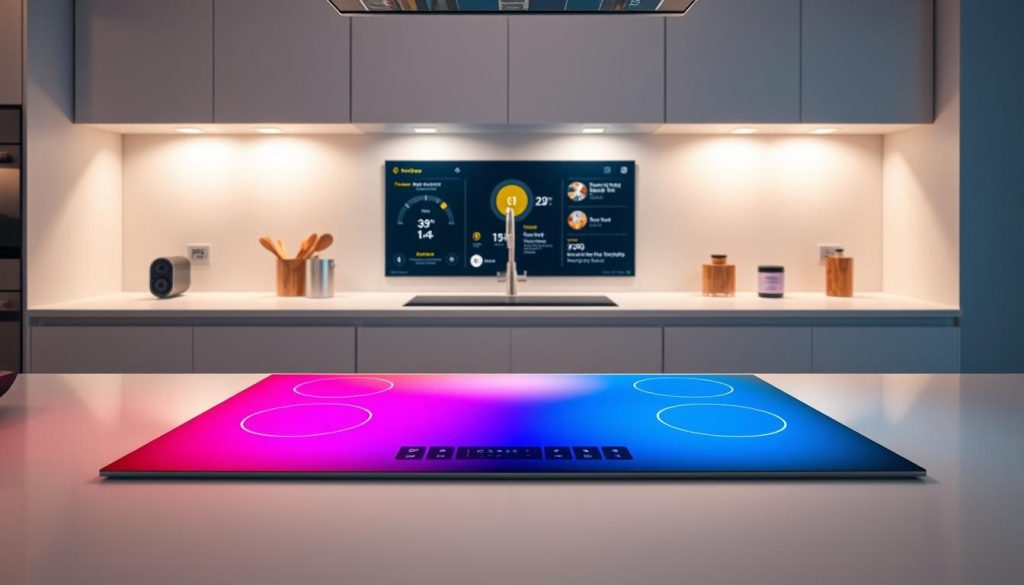
Voice commands through Alexa or Google Assistant let you adjust heat levels hands-free while sautéing. Advanced algorithms analyze your cooking patterns, suggesting optimal settings for dishes like risotto or seared salmon. This technology learns which pans you use most, preheating them automatically during meal prep times.
Your cooktop becomes the command center of your kitchen, syncing with ovens and ventilation systems. Start boiling water from your living room, and the hood fan activates when smoke appears. Safety features like automatic shutoffs engage if pots sit unattended for too long.
| Feature | Smart Cooktop | Traditional Model |
|---|---|---|
| Connectivity | Wi-Fi/App Control | Manual Adjustments |
| Temperature Precision | ±1°F Accuracy | 5-10°F Variance |
| Safety Protocols | Pan Detection + Auto-Off | Basic Overheat Protection |
| Energy Use | Adaptive Power Allocation | Fixed Output Levels |
| Learning Capabilities | AI-Powered Suggestions | None |
Recipe integration transforms complex techniques into guided processes. The system walks you through each step, adjusting heat as needed for perfect caramelization or simmering. Child locks activate when irregular usage patterns occur, adding protection beyond physical knob covers.
With induction technology, energy flows only where needed – reducing waste by 22% compared to conventional models. This efficiency pairs with intelligent automation, creating a kitchen hub that anticipates needs before you recognize them.
Integration with Smart-Home Technology
Your kitchen becomes a command center when appliances collaborate through digital networks. Connected systems transform meal preparation into orchestrated workflows, merging convenience with precision.
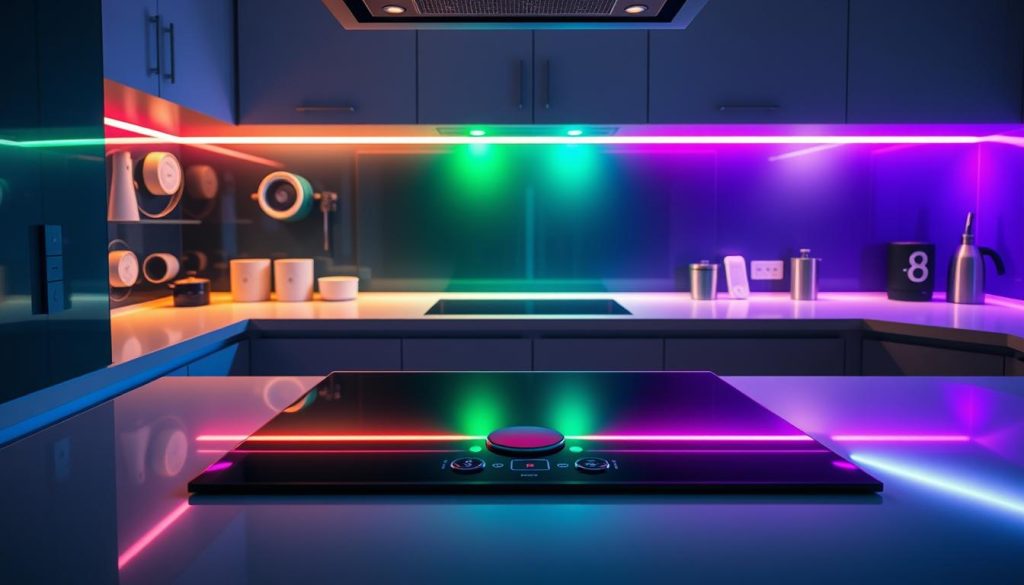
Wi-Fi Connectivity and Remote Monitoring
Samsung’s latest models demonstrate this synergy. Pair your cooktop with their SmartThings app to adjust temperatures from any room. Receive instant alerts if water boils over or pans sit idle too long.
LG’s ThinQ platform takes coordination further. Their ventilation systems activate automatically when sensors detect smoke. You’ll see real-time energy usage graphs and maintenance reminders through the app, optimizing performance without manual checks.
Voice-Control and App Synchronization
“Lower burner three to medium” – your voice command executes instantly through Alexa. Hands-free operation keeps focus on chopping vegetables or stirring sauces. Timers sync across devices, so microwaves finish reheating sides as entrees complete.
Your home ecosystem adapts to routines. Morning oatmeal prep triggers coffee makers, while dinner menus activate hood fans preemptively. Brands now embed technology that learns preferred cookware sizes, adjusting heat distribution for consistent results.
“Interconnected kitchens don’t just respond – they anticipate needs through pattern recognition.”
Induction Cooktops: The Modern Choice
Culinary precision meets cutting-edge engineering in today’s kitchen upgrades. Electromagnetic systems redefine cooking through direct energy transfer, eliminating wasted heat and boosting efficiency. Unlike conventional methods, these surfaces remain safe to touch seconds after use.
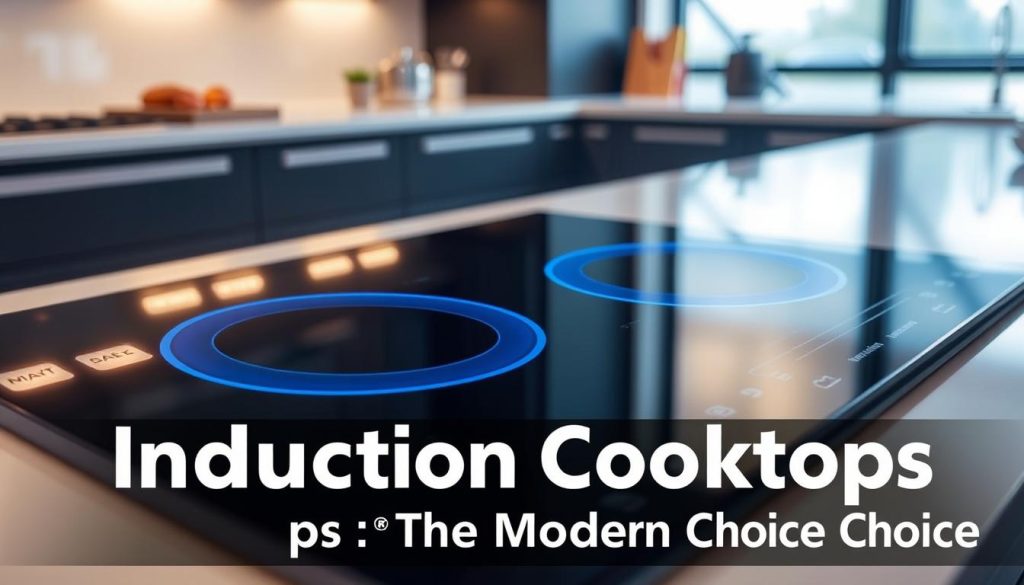
How Induction Technology Sets the Standard
Magnetic fields activate only when compatible cookware contacts the surface. This targeted approach boils water 30% faster than electric coils while matching gas burner speeds. Your cleanup routine simplifies since spills don’t bake onto cool ceramic glass.
| Feature | Induction | Gas | Electric |
|---|---|---|---|
| Heating Method | Magnetic Fields | Open Flame | Radiant Coils |
| Boiling Time (1L water) | 3:10 mins | 3:30 mins | 4:45 mins |
| Surface Temperature During Use | 100°F | 500°F+ | 600°F+ |
| Energy Efficiency | 85% | 40% | 55% |
Instant adjustments let you sear steaks at 450°F, then drop to 200°F for simmering – all with smartphone precision. No more guessing if the burner’s “medium-low” matches your recipe’s requirements.
Safety enhancements protect curious hands and forgetful chefs. Sensors deactivate zones if cookware gets removed, while residual heat indicators prevent accidental burns. Energy savings become measurable, with induction using 15% less power than gas alternatives.
“Induction isn’t just faster – it’s revolutionizing how we approach temperature-sensitive techniques like chocolate tempering.”
Compatibility requires magnetic-based pots and pans, but most stainless steel and cast iron work flawlessly. As kitchens evolve, induction cooktops establish themselves as the responsive, eco-conscious choice for modern homes.
Design and Aesthetic Considerations
Visual harmony meets functional design in today’s kitchen upgrades. Modern cooktops feature Schott Ceran glass-ceramic surfaces that blend sophistication with durability. These sleek glass panels maintain a fingerprint-resistant finish while complementing various countertop materials.
Your kitchen gains a streamlined look through flush-mount installations that sit level with countertops. Premium models offer raised mounting options with stainless steel borders for those preferring statement pieces. Rounded edges create smooth transitions between appliance and workspace, eliminating crevices where crumbs might collect.
Element markings balance discretion with utility. Most models use subtle circles to indicate heating zones, though rectangular or crosshatch patterns cater to different design tastes. These indicators remain visible without disrupting the surface‘s minimalist appeal.
High-end versions incorporate metallic accents that match other stainless steel appliances. The seamless glass expanse eliminates visual clutter from traditional burner grates, enhancing your kitchen’s modern aesthetic. Dark opaque finishes dominate the market, but some manufacturers offer white or gray options for lighter color schemes.
Practical design choices extend beyond appearance. Smudge-resistant coatings simplify cleaning, while recessed controls prevent accidental adjustments. Your cooktop becomes both a functional workhorse and a polished centerpiece through thoughtful engineering.
Size and Element Layout Options
Selecting the ideal cooking surface requires balancing workspace needs with culinary ambitions. Induction models adapt to various kitchen configurations through multiple width choices and intelligent zone arrangements.
Finding Your Fit: Standard Dimensions
Models span 24 to 36 inches wide, with 36-inch versions offering five heating zones – perfect for multi-course meals. Compact 24-inch cooktops suit smaller kitchens while maintaining three elements for essential tasks. Mid-range 30-inch designs strike a balance with four cooking areas.
Flexible Cooking Zones Explained
Circular heating elements range from 6-inch simmer zones to 11-inch power hubs. Advanced models feature bridging technology, combining two zones into oval spaces for griddles or fish poachers. Bosch’s FlexInduction system exemplifies this versatility, automatically detecting pan shapes.
Your cooktop layout impacts meal efficiency. Larger sizes accommodate simultaneous frying and boiling, while modular elements adjust to irregular cookware. Consider cabinet space and typical dish complexity when choosing dimensions – the right size transforms cooking from chore to craft.
